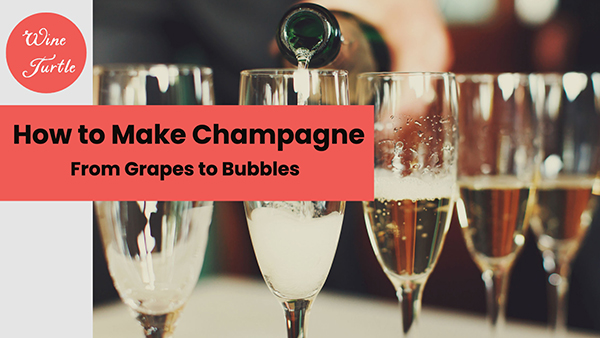How to Make Champagne: From Grapes to Bubbles

Pop the cork and raise a glass! Today, we're going to take a deep dive into the magical world of Champagne.
Bubbly and elegant, Champagne is a symbol of celebration and elegance. But have you ever wondered how it's made?
Read on to learn more about the traditional step-by-step process of making Champagne.
We’ll walk you through the technical intricacies of Champagne production and how they transform humble grape juice into festive, fabulous Champagne.
How to Make Champagne
To be called Champagne, a wine must be made exclusively in the French region of Champagne through specified rules of fermentation, blending, aging, and bottling, a.k.a. méthode champenoise.
These are the steps that go into making this sparkling drink:
1. Harvest the Grapes for Fermentation
Making champagne begins by harvesting grapes between August and October. The time of harvest will vary depending on the ripeness of the grape. The most popular grape varieties used for producing champagne are Chardonnay, Pinot Noir, and Pinot Meunier.
These grapes are always harvested by hand to protect them from bruising and damage before pressing. After handpicking, the grapes are pressed to extract a clear grape juice as the champagne’s base. This juice is known as “cuvée”.
The first press of cuvée is typically the purest and most acidic, which makes it ideal for making a delicate sparkling wine like champagne. With each press, the juice produced is heavier, less acidic, and has more phenols that can make it taste “heavier”.
2. Start the First Fermentation
The pressed juice is poured into stainless steel tanks or oak barrels for initial fermentation at a temperature range of 64 to 68°F.
During the first fermentation, the natural sugar in the grapes will start to break down, producing an acidic still wine.
3. Assemblage
Assemblage is the term used by French winemakers to refer to blending wines for a unique final product.
In Champagne production, the acidic wine from the first fermentation is blended with several reserve wines. The end blend will be the base wine for the rest of the process.
Champagne is typically labeled based on the grape varieties used in its assemblage. Here are the labels and the grape varieties used in each one:
This is the step that determines whether champagne is labeled as brut or doux. Here are the classifications, arranged from least sweet to the sweetest:4. Induce the Second Fermentation
Once the base wine has been blended, it is poured into a champagne bottle with a mixture of sugar, yeast, and yeast nutrients. The bottle is sealed, then placed horizontally in a cool cellar with a temperature ranging from 55 to 60°F.
This induces the second fermentation and produces the carbon dioxide that gives champagne its crisp bubbles. The second fermentation is completed after several months when the yeast cells are dead.
5. Age the Champagne
After the second fermentation, the Champagne continues to age in the cellar. The aging creates the distinct yeasty, slightly toasty flavors of champagne, and this period can last for several years.
According to the Champagne AOC (appellation d'origine contrôlée) guidelines, non-vintage Champagne has to be aged for at least 15 months.
Vintage Champagne, on the other hand, must be aged for a minimum of three years.
Related: Does Champagne go bad? How long does Champagne keep for? Find out in our guide.
6. Riddle the Champagne
Once aging is complete, the winemaker begins riddling the Champagne. The wine bottle is placed upside down on a rack with a 75-degree angle.
Every day, the “riddler” gives the bottle an eighth of a turn. This makes the dead yeast cells (a.k.a. “lees”) float to the top of the bottleneck for disgorging.
7. Disgorge the Lees
When the wine bottle has been turned to the point that it’s standing upside down, it’s time to start disgorging the Champagne lees.
The bottleneck is dipped into an ice-salt bath which freezes the lees, creating a plug of frozen wine and dead yeast cells. When the cap is removed, the carbon dioxide forces or “disgorges” the frozen wine out, spilling a little wine and leaving clear Champagne.
Related: How should you store an opened bottle of Champagne?
8. Add the Dosage
Because a small amount of wine has been spilled from the bottle, winemakers add a combination of sugar, white wine, and brandy to the bottle.
This blend is known as liqueur de tirage. Different combinations can result in different tastes and levels of sweetness, so Champagne houses typically keep their dosage recipes a secret.
Classification | Sugar/Sweetness Level |
|---|---|
Brut mature | No added sugar, < 3 g/L of residual sugar |
Extra brut | < 6 g/L of sugar |
Brut | < 12 g/L of sugar |
Extra dry | 12-17 g/L of sugar |
Sec | 17-32 g/L of sugar |
Demi-sec | 32-50 g/L of sugar |
Doux | > 50 g/L of sugar |
9. Cork the Champagne
After the champagne is dosed, its bottle is corked and caged securely to contain the carbon dioxide bubbles. Post-corking, a bottle of Champagne can be aged for a few more weeks or even years in the bottle.
The longer it ages in the bottle, the more carbonation it loses. However, what you lose in bubbles, you gain in distinct flavors and complexity that make aged champagne truly toast-worthy!
Final Thoughts
Champagne owes its refreshing bubbles and unique tasting notes to its special, carefully controlled production process. The next time you see a bottle of Champagne, check the label to learn how long it’s been aged, what its sweetness level is, and what grapes were used. This information can give you a better picture of your chosen Champagne’s tasting notes and nose.
